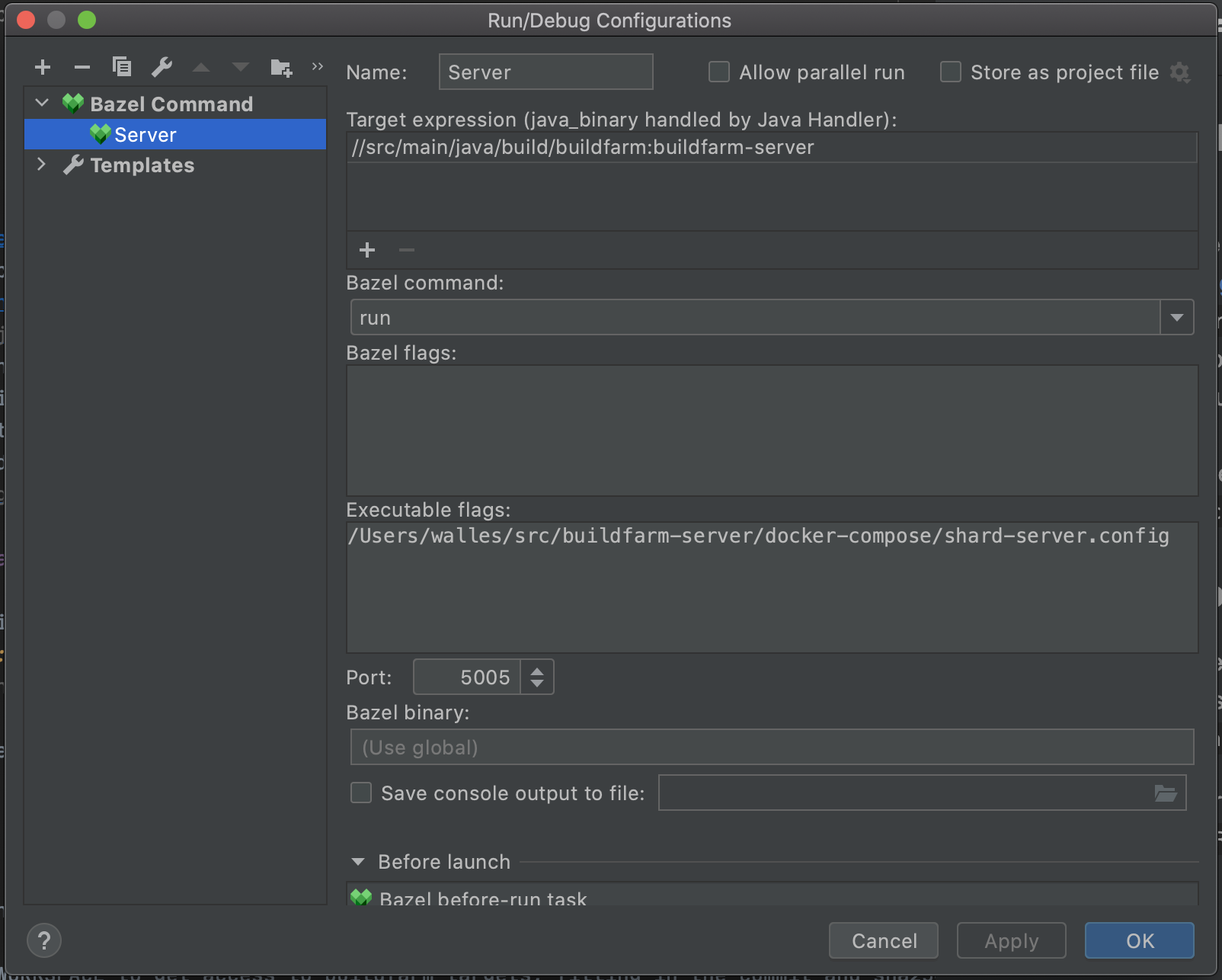Bazel Buildfarm
This repository hosts the Bazel remote caching and execution system.
Background information on the status of caching and remote execution in bazel can be found in the bazel documentation.
File issues here for bugs or feature requests, and ask questions via build team slack in the #buildfarm channel.
Usage
All commandline options override corresponding config settings.
Bazel Buildfarm Server
Run via
bazel run //src/main/java/build/buildfarm:buildfarm-server <configfile> [<-p|--port> PORT]
-
configfilehas to be in Protocol Buffer text format, corresponding to a BuildFarmServerConfig definition.For an example, see the examples directory, which contains the working example examples/server.config.example. For format details see here. Protocol Buffer structure at src/main/protobuf/build/buildfarm/v1test/buildfarm.proto
-
PORTto expose service endpoints on
Bazel Buildfarm Worker
Run via
bazel run //src/main/java/build/buildfarm:buildfarm-memory-worker <configfile> [--root ROOT] [--cas_cache_directory CAS_CACHE_DIRECTORY]
-
configfilehas to be in Protocol Buffer text format, corresponding to a WorkerConfig definition.For an example, see the examples directory, which contains the working example examples/worker.config.example. For format details see here. Protocol Buffer structure at src/main/protobuf/build/buildfarm/v1test/buildfarm.proto
-
ROOTbase directory path for all work being performed. -
CAS_CACHE_DIRECTORYis (absolute or relative) directory path to cached files from CAS.
Bazel Client
To use the example configured buildfarm with bazel (version 1.0 or higher), you can configure your .bazelrc as follows:
$ cat .bazelrc
build --remote_executor=grpc://localhost:8980
Then run your build as you would normally do.
Debugging
Buildfarm uses Java's Logging framework and outputs all routine behavior to the NICE Level.
You can use typical Java logging configuration to filter these results and observe the flow of executions through your running services.
An example logging.properties file has been provided at examples/debug.logging.properties for use as follows:
bazel run //src/main/java/build/buildfarm:buildfarm-server -- --jvm_flag=-Djava.util.logging.config.file=$PWD/examples/debug.logging.properties $PWD/examples/server.config.example
and
bazel run //src/main/java/build/buildfarm:buildfarm-memory-worker -- --jvm_flag=-Djava.util.logging.config.file=$PWD/examples/debug.logging.properties $PWD/examples/worker.config.example
To attach a remote debugger, run the executable with the --debug=<PORT> flag. For example:
bazel run //src/main/java/build/buildfarm:buildfarm-server -- --debug=5005 $PWD/examples/server.config.example
Developer Information
Setting up Redis for local testing
This is done using examples/development-redis-cluster.sh.
Tested with Redis 6.0.10, other versions probably work fine as well.
First of all you need Redis installed:
- macOS:
brew install redis - Debian / Ubuntu:
sudo apt-get update && sudo apt-get install redis-server redis-tools
Then you need eight terminal panes for this. Six for a minimal Redis cluster, one for the Buildfarm server and one for a Buildfarm worker.
./examples/development-redis-cluster.sh 0./examples/development-redis-cluster.sh 1./examples/development-redis-cluster.sh 2./examples/development-redis-cluster.sh 3./examples/development-redis-cluster.sh 4./examples/development-redis-cluster.sh 5-
redis-cli --cluster create 127.0.0.1:6379 127.0.0.1:6380 127.0.0.1:6381 127.0.0.1:6382 127.0.0.1:6383 127.0.0.1:6384 --cluster-replicas 1
Your Redis cluster is now up, and you can now start your Buildfarm server talking to it:
bazel run //src/main/java/build/buildfarm:buildfarm-server $PWD/examples/shard-server.config.exampleAnd your Buildfarm worker:
mkdir /tmp/worker
bazel run //src/main/java/build/buildfarm:buildfarm-shard-worker $PWD/examples/shard-worker.config.exampleSetting up intelliJ
-
Check which IntelliJ versions are supported by the Bazel plugin
-
Make sure you have a supported IntelliJ version, otherwise download one here
-
Follow the Bazel plugin instructions and import
ij.bazelproject -
Once IntelliJ is done loading your project, open
BuildFarmServer.javaand find themain()method at the bottom -
Press the green play button symbol in the gutter next to
main()to create a Bazel build configuration for starting a server. Launching this configuration should get you a help text from Buildfarm Server indicating missing a config file.This indicates a successful launch!
-
To add a config file, edit your new run configuration and enter the absolute path to
examples/server.config.examplein the "Executable flags" text box.
Now, you should have something like this, and you can now run / debug Buildfarm Server from inside of IntelliJ, just like any other program:
Third-party Dependencies
Most third-party dependencies (e.g. protobuf, gRPC, ...) are managed automatically via
rules_jvm_external. These dependencies are enumerated in
the WORKSPACE with a maven_install artifacts parameter.
Things that aren't supported by rules_jvm_external are being imported as manually managed remote repos via
the WORKSPACE file.
Deployments
Buildfarm can be used as an external repository for composition into a deployment of your choice.
Add the following to your WORKSPACE to get access to buildfarm targets, filling in the commit and sha256 values:
load("@bazel_tools//tools/build_defs/repo:http.bzl", "http_archive")
BUILDFARM_EXTERNAL_COMMIT = "<revision commit id>"
BUILDFARM_EXTERNAL_SHA256 = "<sha256 digest of url below>"
http_archive(
name = "build_buildfarm",
strip_prefix = "bazel-buildfarm-%s" % BUILDFARM_EXTERNAL_COMMIT,
sha256 = BUILDFARM_EXTERNAL_SHA256,
url = "https://github.com/bazelbuild/bazel-buildfarm/archive/%s.zip" % BUILDFARM_EXTERNAL_COMMIT,
)
load("@build_buildfarm//:deps.bzl", "buildfarm_dependencies")
buildfarm_dependencies()
load("@build_buildfarm//:defs.bzl", "buildfarm_init")
buildfarm_init()Optionally, if you want to use the buildfarm docker container image targets, you can add this:
load("@build_buildfarm//:images.bzl", "buildfarm_images")
buildfarm_images()
load("@build_buildfarm//:pip.bzl", "buildfarm_pip")
buildfarm_pip()